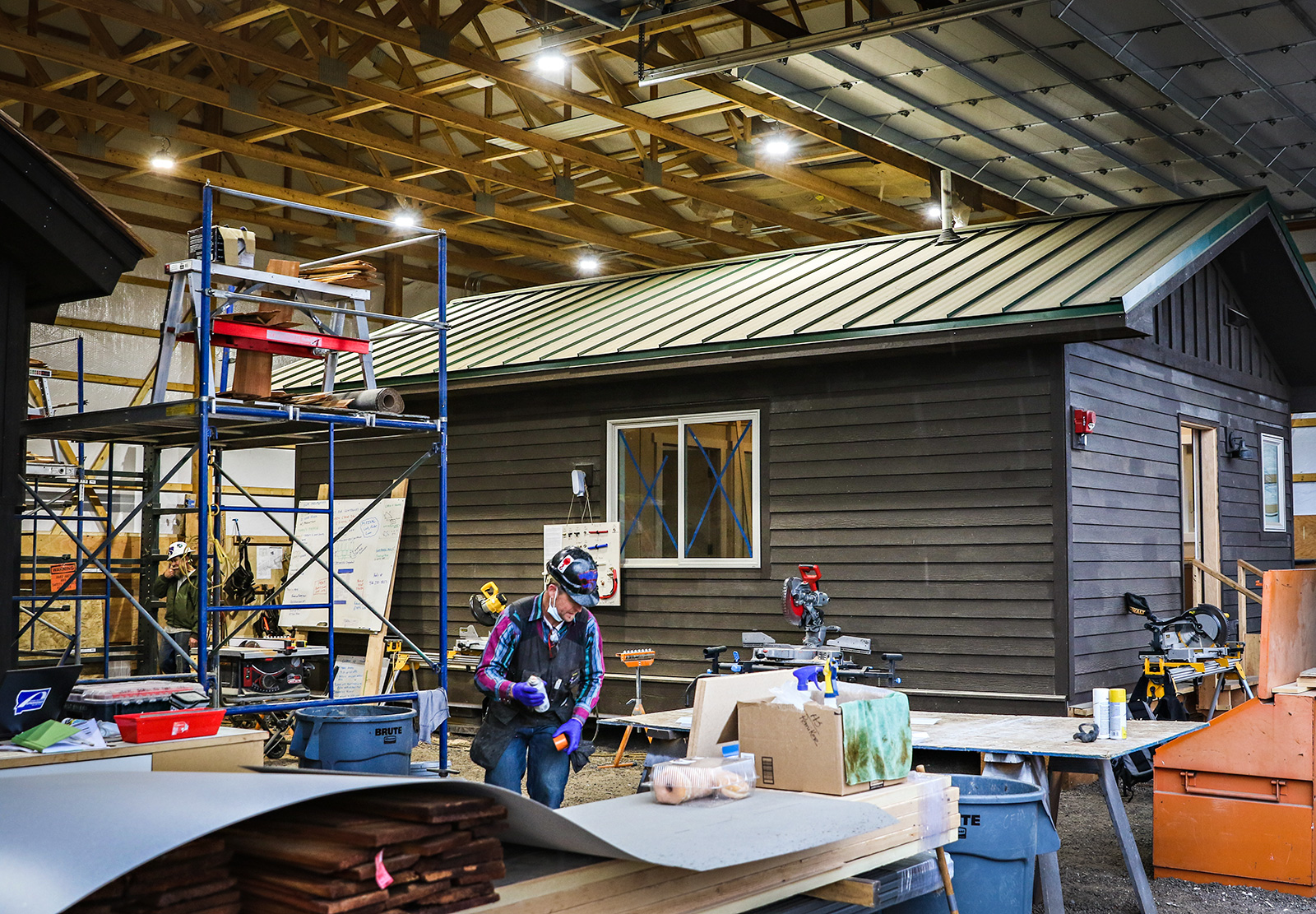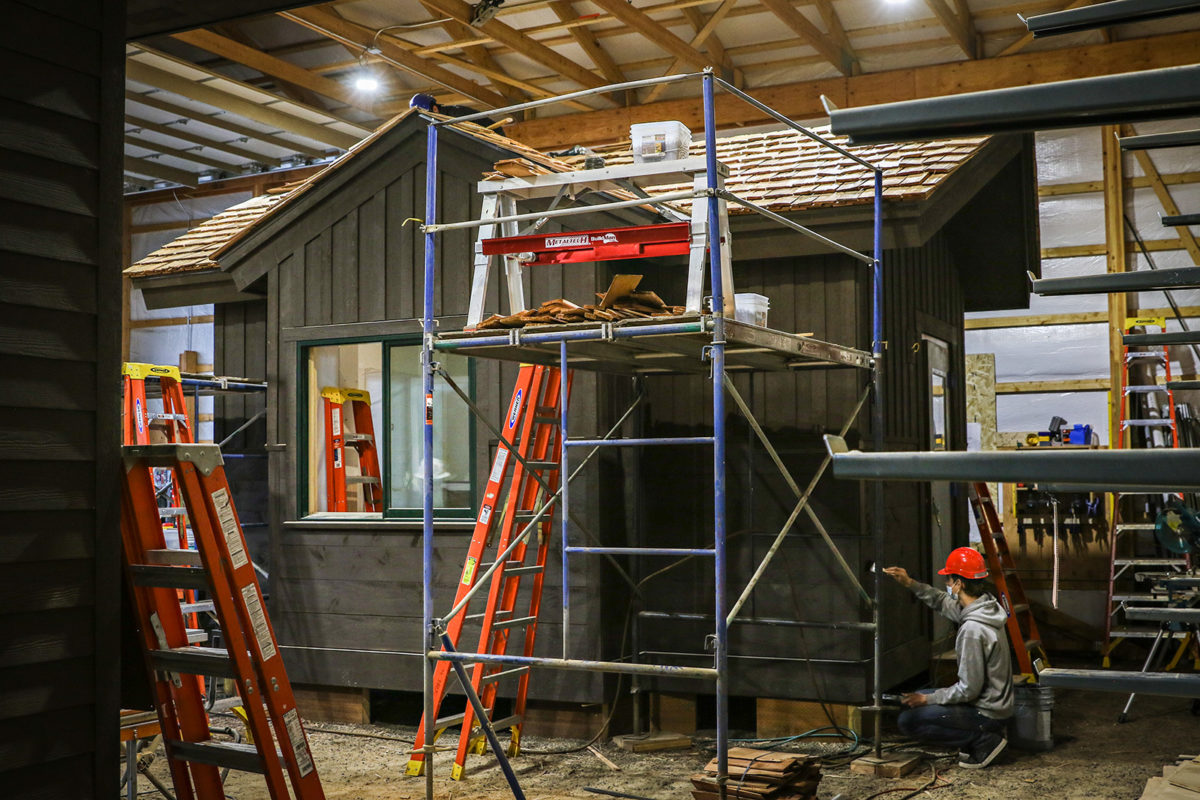
Building Housing for Park Employees While Building Opportunities for Students
In second year of School-to-Park partnership, Columbia Falls High School students build new cabin and kiosk to be moved into Glacier Park in July
With Columbia Falls High School’s summer break just a few hours away on June 9, students in Jeff Remiker’s Business Trades class put finishing touches on a new employee cabin that will be placed at Rising Sun in Glacier National Park this summer.
As students cut out countertops and hammered in the cedar shake roof atop an eight-foot-high scaffolding, the classroom was a live construction site.
Since the start of the school year, students have been working hard to construct two projects, the two-bedroom cabin and a new entrance station kiosk for Camas Road, from frame to finish. On any given day, there would be saw dust flying everywhere, chop saws shearing and power drills humming as students learned virtually every aspect of house building.
The projects are part of the School-to-Park partnership between Glacier National Park and Columbia Falls High to provide housing for park employees.
“It’s a great partnership with the National Park Service being right in our backyard and with the kids getting the skills they need to hopefully enter the workforce we have here in the valley,” Remiker said.
For Mae Anderson, the experience was especially novel as the only girl in the class. Anderson, a junior, and her classmates laid sheetrock in the bathroom, sanded the tongue-and-groove ceiling and set the windows, among numerous other tasks.
“I had never done anything like this before,” she said. “It’s pretty neat to be able to say that you actually built the entire thing.”

The program arose from park Chief of Facilities Management Jim Foster’s efforts to address employee housing. Without enough units to rent to employees, the housing shortage within the park interferes with staffing and operations in peak season. Understanding that funding is always a challenge, Foster got creative.
After learning of a School-to-Park program that was started back in 2001 with Denali National Park in Alaska and a local school system, Foster approached Columbia Falls High in 2018 with an idea to reproduce a similar program. Columbia Falls High Principal Scott Gaiser and former Superintendent Steve Bradshaw, along with Remiker, embraced it and began planning the new program for the 2019-2020 school year.
Although the students could be taught to build, equipment and infrastructure remained question marks, according to Doug Mitchell, executive director of the Glacier National Park Conservancy. The tools and space students used for jewelry box construction were unfit for their new house construction project.
The park was willing to provide students tool belts and building materials and staff the classroom with the experienced Glacier Park carpenter Bob Jellison. With funding and support from School District 6, Bradshaw and the school’s maintenance department brainstormed ways to make new space. By 2019, a 50-by-80-foot pole barn was built outside behind the shop classroom.
There was one last hurdle: getting power to the new construction site. Neither the park nor the school could fund a solution, but they found one.
“That was something we could do,” Mitchell, with the Conservancy, said.
With a $15,000 grant from the Conservancy, Glacier National Park’s official fundraising partner, the students could complete the project efficiently with the new power source and in time for seasonal employees.
Under the watchful eye of Jellison, students learned plumbing, carpentry and electrical skills, while overcoming frustrations through cooperation.
“Bob does an extraordinary amount of work to keep this program going,” Foster said of Jellison. “I mean, its success is really on his back.”
In addition to providing much needed housing for two park employees this summer, students know the partnership is preparing them for the real world, too.
“Students leave the program with a tool belt in hand, an apprentice certificate that’s offered to them by the state and an opportunity if they want to become a carpenter or any apprentice,” Foster said.

Lane Enello, a junior, plans to build on his learning and pursue an electrician apprenticeship after graduating.
“It’s gonna be really helpful for when we get out of school,” Enello said. “You already have so many hours that you’ve already started on a career path.”
Students can apply these hours to enter any state-approved apprenticeship program they choose, with more than 1,000 in the state.
“If they’re applying for a job with 360 hours and an OSHEA 10 training certificate, their application floats to the top of the stack,” Remiker said.
According to Terry Aubrey, a registered apprenticeship representative for the Montana Department of Labor and Industry in Kalispell, the demand for construction laborers and skilled workers is extremely high. The program could also draw more women into the trades workforce, as Anderson exemplifies.
“People need to get beyond the stereotypical, ‘if they’re a plumber, it’s a male,’ so they can tap into the available workforce,” Aubrey said.
Foster has no intention of the partnership going away.
“This model of utilizing our local high schools to help the parks should be used in every park that can do it,” Foster said. “I think this can be exported across the nation.”
And there’s already one special partnership he’s dreaming about: involving Blackfeet students.
“Because that’s one of the things we want to be: a good partner to our tribal neighbors,” he said. “That would be my capstone.”